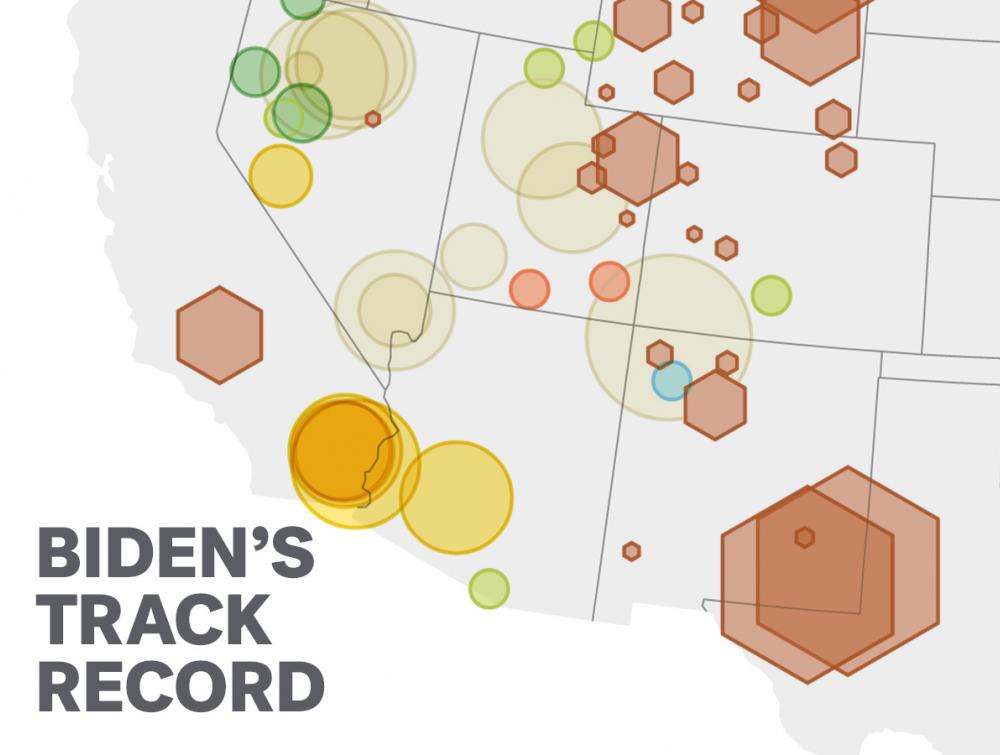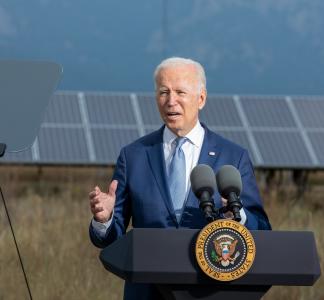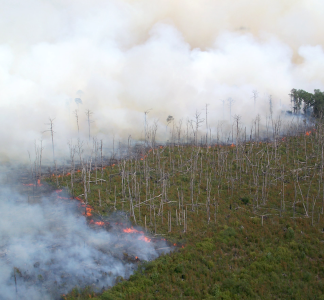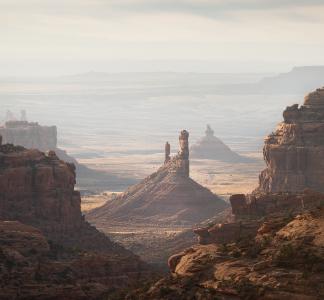Biden’s record on public lands and waters — in 3 maps

Positive conservation steps, slow start on climate and energy
President Biden has been at the helm of the country for just over a year. Throughout this time, we’ve been keeping an eye on his administration’s management of public lands and waters. These places play a significant role in either mitigating or worsening the climate and extinction crises that are impacting wildlife and communities.
Here are three burning questions (with three maps) that help us understand President Biden’s stewardship from Jan. 2021 to Jan. 2022:
1. Is President Biden tackling climate pollution coming from public lands and waters?
2. Is Biden protecting naturally and culturally important lands and waters as promised?
3. Has Biden advanced a "Clean Energy Revolution" on public lands and waters?
From day one, Biden vowed to treat the climate crisis with the urgency and seriousness that it deserves. That meant slashing the country’s greenhouse gas emissions, among other climate goals. Reducing the climate pollution coming from fossil fuel development on public lands and waters was crucial to that plan. But after one year, we’re still waiting for real progress.
The president made a campaign promise to “ban new oil and gas permitting on public lands and waters.” Instead, his administration has issued a total of 3,557 new drilling permits so far. As the map shows below, these approvals are largely located in the West, with the highest number of wells planned for Lea County, N.M. Combined, all of those projects could lead to climate pollution equivalent to the annual emissions of 86 million cars.
The number of new drilling permits is 33 percent higher than Trump’s first year total. While many factors can influence the issuing of new permits, including past leasing rates, the federal government has the discretion to issue or deny them based on environmental and other factors.
Meanwhile, the Biden administration has continued to hold lease sales to the fossil fuel industry, breaking another campaign promise. The president started strong by pausing this outdated system, which hands public lands over to polluters with little scrutiny. But when a federal court invalidated the pause, Biden was left in a complicated position to deliver on his promises.
However, it was not impossible: As with drilling permits, the administration could have elected not to lease public lands and waters.
Instead, they went ahead and held a massive offshore lease sale, offering 80 million acres in the Gulf of Mexico to the oil and gas industry. Development of those acres would have generated the same amount of emissions as what comes out of 112 million cars’ tailpipes in a full year. The sale was eventually canceled by a judge concerned with the project’s climate impacts.
To complicate things even more, a recent court ruling blocked the Biden administration from weighing the cost of climate change in its decisions. In response, the government has again paused leasing and now also permitting. But the ruling makes it harder to account for climate change in future oil and gas activities, including potential lease sales.
What we want to see: Continuing to hand off public lands to the fossil fuel industry without any consideration for climate change will have long-term consequences. President Biden should phase out fossil fuel drilling and promote a just transition to renewable and sustainable energy. It’s time to use every tool at our disposal to make sure public lands are serving people, not polluters.
Before taking office, then-President-elect Biden said he would work to protect at least 30 percent of America’s lands and waters by the year 2030. It was welcome news: scientists have said that should be the global goal at a minimum if we’re going to slow rapid loss of nature and reserve spaces to help communities and wildlife adapt to climate change. A few months later, the administration released a first-of-its-kind national conservation goal that confirmed that ambitious mission. The president also pledged to “establish parks and monuments that reflect America’s natural heritage,” a nod toward protecting Indigenous and other cultural resources on public lands.
So, is President Biden living up to it? In short, he has certainly helped us get the ball rolling. But much work remains.
President Biden’s signature public lands achievements so far have been steps to reverse Trump administration attacks. Chief among these sorely needed actions were restoration of full protections for Bears Ears, Grand Staircase-Escalante and Northeast Canyons and Seamounts national monuments; reinstatement of “roadless” forest protections on the Tongass National Forest in Alaska; and, just after the one-year mark of his presidency, cancellation of toxic mining leases next to the Boundary Waters Canoe Area Wilderness in Minnesota.
Those were the big-ticket items. But the Biden administration did take some lesser-known steps, too, including adding thousands of acres to national wildlife refuges in eight states. The expansions secured important migratory stops for ducks and other birds as well as habitat for wildlife like bobcats and endangered ocelots.
The Biden administration also designated Connecticut National Estuarine Research Reserve and is in the process of establishing the Chumash Heritage National Marine Sanctuary off California, protecting habitat for sensitive sea life.
As for protecting important historic and cultural sites, the Biden administration’s work on the Chumash Heritage site will conserve submerged villages and cultural sites sacred to the Chumash people, and the recent designation of the Wisconsin Shipwreck Coast National Marine Sanctuary protects dozens of historically significant shipwrecks in Lake Michigan. Biden is also pursuing steps that would protect the area around Chaco Culture National Historical Park in New Mexico from oil and gas development, shielding cultural sites with connections to the Pueblo, Hopi and Navajo peoples.
And as part of the White House Tribal Nations Summit, the Biden administration took steps to improve protection of, and increase access to, Indigenous sacred sites, and incorporate Traditional Ecological Knowledge into public land management.
What we want to see: President Biden should move ahead with lasting safeguards for important Indigenous cultural sites like Avi Kwa Ame in southern Nevada and Great Bend of the Gila in Arizona, and work to provide access to nature for underserved communities in places like the Castner Range in Texas. To stem the tide of the human-caused mass extinction and nature-loss crisis, he must also continue to expand the national wildlife refuge system. That step will help increase access to nature as well; many refuges lie near cities, providing critical open space for communities of color and low-income communities that may face social, economic and physical barriers.
During his campaign, President Biden pledged a “Clean Energy Revolution” that would boost renewable energy production and accelerate the transition away from fossil fuels. A crucial part of that plan was to develop more renewable energy on U.S. public lands and waters. While progress has been made, the administration is off to a very slow start.
Today, public lands host fewer than 100 utility-scale renewable facilities. Combined, they generate a mediocre 6 gigawatts (GW) of clean energy–enough to power 2 million homes. The president has promised to boost production by permitting an additional 25 GW of clean energy on public lands by 2025.
But as the map shows below, the administration has approved only 10 new solar and geothermal projects on land. Mostly located in the West, they are set to generate about 1.5 GW of clean energy–only 6 percent of Biden’s goal. (When counting 10 gen-tie projects, which are sited on private lots but have power lines and access roads going through public lands, the share of Biden’s goal is 16 percent.)
On public waters, it’s a similar story. The president has pledged to permit 30 GW of renewable energy by 2030, but only two offshore wind farms were authorized off the Northeast coast. Combined, they will produce less than 1 GW of clean energy, a mere 3 percent of the president’s goal for waters.
A recent lease sale near Long Island and New Jersey shows some promise for the future, but it could take years before projects are up and running.
The sluggish pace of approving renewables on public lands and waters is not new. Offices like the Bureau of Land Management (BLM) have long struggled with inadequate funding, staffing and expertise. Developers face delays in getting the green light for leasing requests, building and operation plans. Many proposals never see the light of day.
Congress attempted to address the issue in 2020 by demanding the re-establishment of National Renewable Energy Coordination Offices, which are responsible for expediting permitting on federal land. So far, the offices are yet to be fully staffed and functional.
There are other ways to speed up renewable infrastructure on public lands and do it in a responsible way. The BLM could take advantage of the “solar zones” they have already identified as good spots for development. These lots, which were selected because they steer clear of sensitive wildlife habitat and cultural resources, could support hundreds of responsible projects (pending meaningful tribal consultation). Yet these areas are largely sitting empty.
What we want to see: President Biden needs to seriously pick up the pace by approving renewable energy projects on select public lands and waters--for example, prioritizing responsibly sited projects on existing solar zones that avoid sensitive habitat and cultural areas. This must include meaningful consultation with tribes to ensure important sites are not harmed and include full federal funding of tribal historic preservation offices that are integral to the process. It’s the only way to meet the president’s goals and curb the climate crisis that becomes more pressing by the day.



